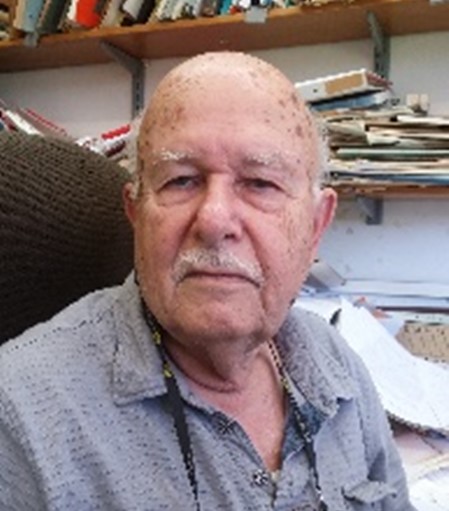Keynote Speaker

Prof. Shlomo Nir
Professor EmeritusThe Hebrew University of Jerusalem (HUJI)
Israel
Speech Title: Water purification from bacteria, cyanobacteria, and toxins by filtration and biocidal free cations: modeling of filtration and degradation during filtration
Abstract: Removal of pathogenic microorganisms by filtration provides safe water, and reduces harmful disinfection by products. Ordinary micelle-clay complexes have a relatively large surface area, large hydrophobic fractions, and are positively charged to half of the cation exchange capacity of the clay. Granulated micelle-clay composites (0.4 to 2mm) formed by organic cations, e.g., ODTMA (Octadecyltrimethylammonium), have the capacity to remove from water by filtration a wide array of microbial contaminants: (a) Escherichia coli S-17; (b) total bacteria count (TBC); and (c) Cyanobacteria (Microcystis and Aphanizomenon). Filters included the complex exclusively, or mixed with sand. A model which considered convection, adsorption, and desorption simulated the filtration results and yielded predictions. Calculated capacities (emerging bacteria <1 per 100 mL) were (for a 1m long filter at a flow velocity of 10 m/h) 5 to 100 m3/ kg of complex for water including 5∙106 to 1∙103 E. coli bacteria/mL, respectively. Regeneration of used filters was by: (i) dilute solutions of NaOCl, or HCl, or (ii) heating in a furnace or (iii) by microwave radiation, which gave the best results. Removal capacity of TBC was smaller than in (a), but the technology enables to avoid using UV lamps in domestic filters. Bacteria capture by filtration was shown to be more efficient, due to biocidal/ biostatic effects of released cations. Placing a layer of activated carbon after the micelle-clay filter reduced the released cations to 1µg/L. A newly designed enriched complex with a larger ODTMA load to utilize both filtration and biocidal/biostatic activity of free cations, yielded enhanced capacity in removal of bacteria from water. Free ODTMA cations at concentrations of 30 and 90 mg/L at 5 min contact imposed full inhibition of the photosynthetic activity in cultures of Aphanizomenon and Microcystis, respectively, whereas for 20 min incubation, complete killing of these cells occurred at cation concentrations of 80 µg/L and 6 mg/L, respectively. Filtration of cyanobacteria was efficient and was adequately modelled. The estimated capacity of a 1m long filter (flow velocity 6m/h) to purify water, which includes 106 Microcystis cells per mL to drinking standards is 22 m3/ kg of complex. The calculation assumed 10-fold reduction in cell number by a first step of coagulation/sedimentation. The capacity of ODTMA nano-composite to remove cyanotoxins, microcystins (MCs) from water to below 1 µg/L via filtration was determined. Higher capacities were observed for the removal of MC-LR, MC-WR, MC-3aspWR and MC-Y, whereas substantially lower capacities were recorded for more positively charged MC congeners, such as MC-RR and MC-3aspRR. Filtration results were simulated by the filtration model, for solutions including one to several toxins. In agreement with model predictions, results demonstrated that in the presence of MC-WR the emerging concentrations of MC-RR congeners eventually exceed their solution values. In conclusion, nano-composites of ODTMA-bentonite can be applied for removal of bacteria, cyanobacteria and cyanotoxins, microcystins from drinking water. Cyanotoxins and off flavour molecules were observed to be efficiently removed from water by a process of bacterial degradation during filtration. A model developed yielded good predictions for experimental results. The model predicts an establishment of a steady state.
Keywords: Nano-composite; Granulated micelle-clay; Filtration modeling; Removal of bacteria; Biocidal effects; Cyanotoxins; Microcystins; Modeling filtration; Modeling degradation during filtration
Biography:
1969 Ph.D-Theoretical Physics.
1970 Fellow, Inst. Life Sciences,HUJI.
1970-1980. RPMI, Buffalo NY. Cancer Research Scientist I-IV, and Assoc. Prof. Biophysics; University of NY, Buffalo.
1980 Assoc. Prof. HUJI ; Dept Soil and water Sciences.
1985 Professor.
2003 Professor Emeritus.
Recent research mainly on Water Purification and teaches a graduate course. Developed models for:
1. Simultaneous adsorption of several inorganic and organic cations to surfaces, by accounting for electrostatic equations and specific binding in a closed system. The model has been applied to artificial and biological membranes and to clay-minerals.
2. Particle aggregation, extent and kinetics.
3. Membrane fusion and.endocytosis.
4. Pore formation by peptides.
5. Kinetics of filtration for a solution with several pollutants. The model has yielded simulations and predictions for removal of chemicals and bacteria for laboratory and pilot scales.
6. Filtration and degradation. The model, which predicts steady sate phenomena was recently applied in (i)removal from fish ponds of off flavor compounds and (ii) removal of bacteria. Designed a complex between organic cations and clay-minerals or clays, which has been efficient in removal of chemicals (mainly anionic and hydrophobic) and microorganisms, such as bacteria, viruses and a parasite, Cryptosporidium.
Guided 11 Ph.D and 15 M.Sc students.
Published 259 articles in peer reviewed scientific Journals and books, 4 books, 6 patents;
h-index 79.
